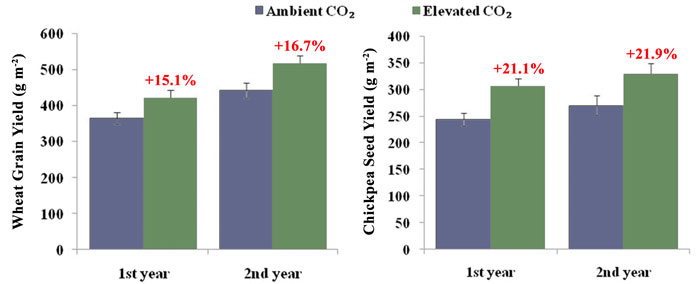| Tweet | Follow @co2science |
Paper Reviewed
Chakrabarti, B., Singh, S.D., Bhatia, A., Kumar, V. and Harit, R.C. 2020. Yield and nitrogen uptake in wheat and chickpea grown under elevated carbon dioxide level. National Academy Science Letters 43: 109-113.
Chakrabarti et al. (2020) note that wheat (Triticum aestivum) and chickpea (Cicer arietinum) "are the two important crops which contribute significantly to India's food security." In light of such importance, the team of five researchers set out to quantify the impacts of elevated atmospheric CO2 on this cereal (wheat) and legume (chickpea).
Their study was conducted at the ICAR-Indian Agricultural Research Institute farm in New Delhi, India. Over two consecutive growing seasons Chakrabarti et al. grew wheat (cv. PBW 343) and chickpea (cv. BGD 72) in a FACE environment under ambient (390 ppm) or elevated (550 ppm) CO2 levels. Not surprisingly, as indicated in Figure 1 below, the 160 ppm increase in atmospheric CO2 stimulated the growth and yield of both agricultural crops. For wheat, grain yields increased by 15.1% and 16.7% in the 1st and 2nd growing seasons whereas for chickpea, seed yields increased by 21.1% and 21.9%.
Chakrabarti et al. also examined the grain and seed nitrogen concentrations under the two CO2 treatments, finding no change in chickpea and a slight (3 to 5%) decline in wheat that could potentially be compensated for by the application of additional nitrogen fertilizer. It was also noted that both crops became more efficient in their use of nitrogen (N), converting greater amounts of carbon into plant sinks (particularly the grains and seeds) per unit of nitrogen uptake. Consequently, in light of all of the above, the five scientists conclude that "increased atmospheric CO2 will increase the yield of C3 crops like wheat and chickpea." And that is a very important finding for a country like India which continues to increase its population and has concerns about achieving and maintaining food security.

Figure 1. Impact of elevated CO2 on wheat grain (left side) and chickpea seed (right side) yields in two consecutive growing seasons. Red text indicates the percentage increase due to elevated CO2 in each growing season for each crop, which increases are all significant at the p ≤ 0.05 level. Error bars indicate standard deviations. Adapted from Chakrabarti et al. (2020).




